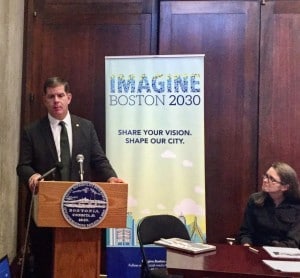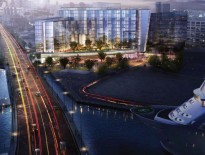
Boston Mayor Marty Walsh speaks at a 2016 event touting the city's Imagine Boston 2030 planning initiative. Photo courtesy of the city of Boston.
A draft report of Imagine Boston 2030 – the first citywide master plan in a half-century – released Thursday spotlights concerns about housing prices and displacement of lower- and middle-class residents, recommending that developers be given density bonuses to include income-restricted affordable units in multifamily projects.
Rebekah Emanuel, executive director of the Imagine Boston 2030 program, said the year-long study details wide disparities in economic well-being and access to jobs and transportation among Boston neighborhoods.
The Boston Planning and Development Agency is already proposing housing density bonuses in the Jamaica Plain-Roxbury corridor as part of a controversial rezoning proposal. The plan sets a goal of 30 percent affordable units in new development, with developers given the right to build taller structures. Activists have protested the plan and called for 70 percent income-restricted housing in new units.
Likewise in South Boston, the BPDA is considering rezoning the Dorchester Avenue corridor between the MBTA’s Broadway and Andrew Square stations for high-rise housing and mixed-use projects.
And a new inclusionary development policy enacted in January increased minimum allocations of affordable units in new developments and raised “opt-out” fees for developers who choose not to include them on-site in the city’s higher-cost housing markets.
Boston Mayor Martin Walsh said the policy needs more time to accomplish its goals.
“It seems to have stabilized the market to some degree and stopped those big spikes in rents,” Walsh said at a media briefing. “The first year we didn’t receive much of a benefit. I suspect in 2017 we’ll have much more.”
Walsh flatly dismissed suggestions that overdevelopment is a concern, saying the city wants to encourage “growth zones” in areas such as South Boston’s Widett Circle. The report also sets a priority of expanding jobs in areas such as Newmarket, Dudley Square and Uphams Corner.
“We have to identify other areas in the city where we can grow and expand,” Walsh said.
The report puts a priority on creating mixed-use job centers in neighborhoods such as Charlestown’s Sullivan Square, East Boston’s Suffolk Downs and Allston’s Beacon Yards, along with an industrial section of Readville and the South Boston waterfront.
Goals in the draft report reflect comments collected by more than 12,000 residents over the past year.
A full version of the draft report is available here.




 |
| 
